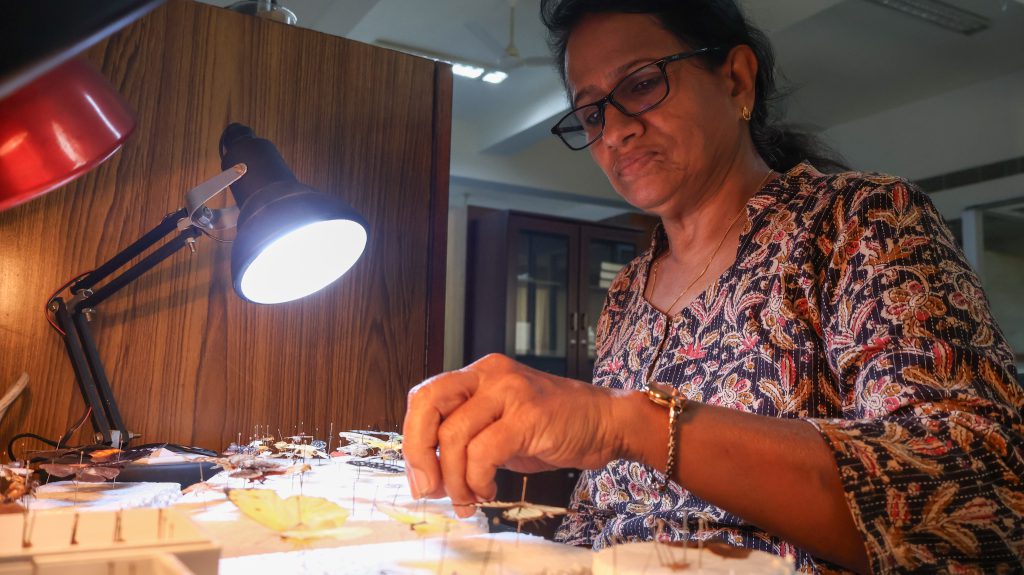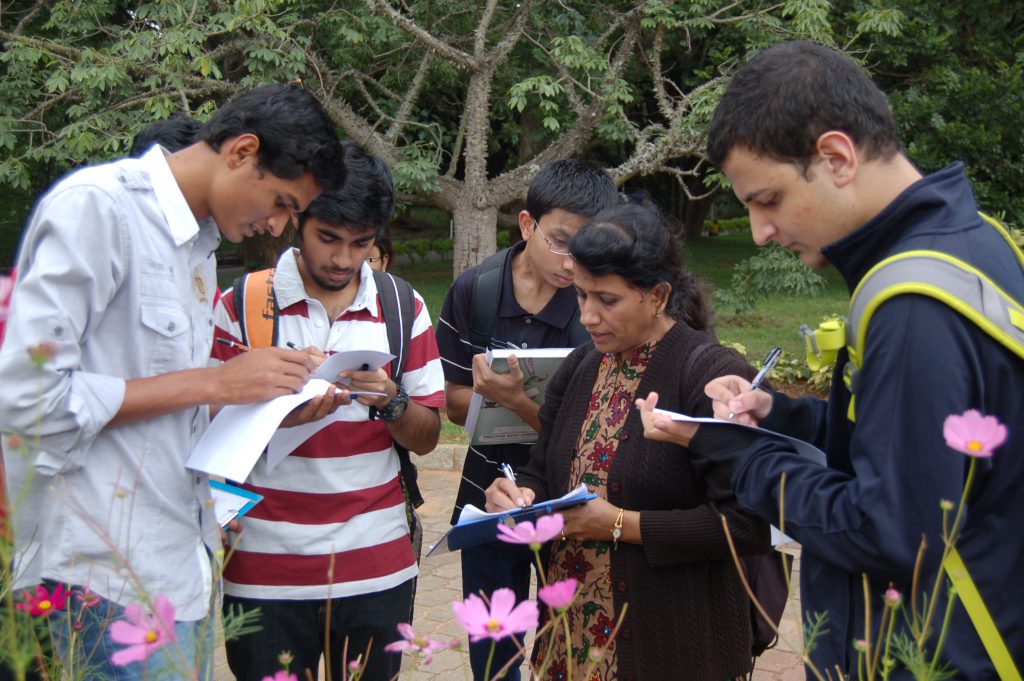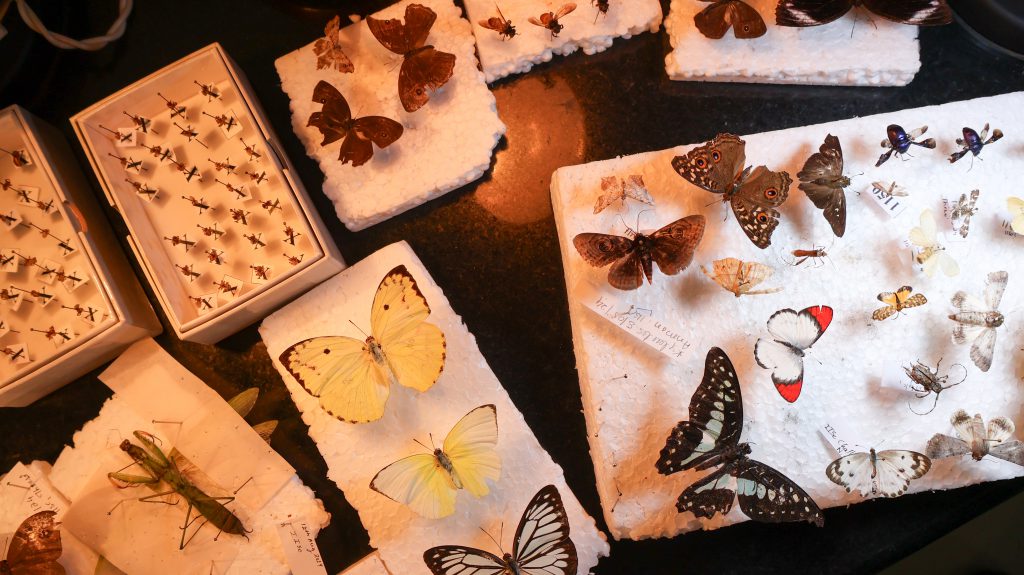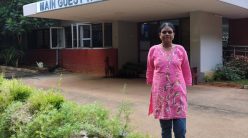Thresiamma Varghese shares the joys of discovering and preserving critters

It was a rainy day and piercing cold winds swept through the third floor of the new Biological Sciences building. I pushed open the creaky museum door, stepping into the big, dimly lit room. It was warm inside, and I could smell the ethanol used for preserving the insect samples. Walking through the long hall of the museum, I saw colourful butterfly specimens on display on one side of the walkway.
Perhaps the creaky door had given me away. Thresiamma Verghese, the person in charge of the museum at the Centre for Ecological Sciences (CES), came to greet me near the sliding door of her cabin. Inside, the space was crammed with books, files, and vials with insects like ants and wasps suspended in alcohol.
As I sat on one side of the table, I could sense that Thresiamma was energetic, even excited. I have known her for about a year now; the lab that I was a part of, headed by faculty member Kavita Isvaran, neighboured the museum in the B wing of CES. Thresiamma was always happy to speak to me and other visitors of the museum, sharing her vast knowledge of the specimens on display. But today, I had come to her cabin to learn more about her life.
Thresiamma was born and raised in the Kottayam district of Kerala before moving to the Malabar region for high school. Her parents owned coconut and rubber plantations and had five children before welcoming Thresiamma to the family. One of her fondest childhood memories of her home state was spending time amidst greenery.
One of the fondest childhood memories of her home state Kerala was spending time amidst greenery
“The place I grew up was surrounded by serene nature. During monsoons, we siblings used to go around the lush green fields and play in the water, and in summer, fishing and swimming used to be part of our daily ritual,” Thresiamma recalls.
Her love for nature influenced her decision to pursue science in her pre-university studies at St Joseph School, Kannur. She excelled in her classes and aspired to become a doctor, but unfortunately, she did not make it to the merit list that year. Her older brother, who worked at the Bhabha Atomic Research Centre (BARC) as a SEWA Assistant Engineer, advised her to study chemistry, as it would improve her chances of securing a job. Another brother, now a retired bank manager, advised her to get into banking. In the end, she chose to study zoology for her Bachelor’s degree; though botany was her favourite, the local college did not offer the subject.
Her family was in favour of her studies, even during a time when girls were not permitted to leave their homes on their own. Her parents couldn’t pursue higher studies due to societal pressures and therefore valued and encouraged their daughter’s education.
With her parents’ support, she finished her MSc in Zoology and pursued a PhD at Calicut University under the guidance of the late TC Narendran. Her research during her PhD focused on behaviour and ecology of orb web-building spiders.
In the last year of her studies, she moved to Bangalore after marriage. Two years later, she applied for a DBT research associate fellowship at IISc. Following the interview and presentation, she was offered the position. However, she faced a dilemma as none of the labs at IISc were focusing on the expertise she had gained during her PhD.
MRN Murthy, a professor at the Molecular Biophysics Unit (MBU) and a panel member for her interview, recommended that she join the lab of Raghavendra Gadagkar, who was then a professor at CES. Now retired, Gadagkar was doing research on the behavioural ecology of social insects such as paper wasps (Ropalidia marginata) and honeybees, which was closest to what Thresiamma was interested in working on.

As there were no openings in his lab, Gadagkar suggested that she become a visiting scientist for a year and then reapply for the fellowship. “At that time, there were already three postdocs working with him, and I believe there were limits on the number of students that professors could take. Nevertheless, I applied the following year and was accepted into his lab,” remembers Thresiamma.
Although the main focus of Gadagkar’s lab was on paper wasps and honeybees, there was also a significant project on ant behaviour and taxonomy. Thresiamma decided to join this project. Though she holds a MPhil in Taxonomy, working with ants was a new topic for her. “Padmini Nair, who was a project assistant in Gadagkar’s lab at the time, was the backbone of the museum. She was a wonderful person and taught me a lot about museum techniques, such as filling alcohol and identifying ants,” Thresiamma recalls.
In 2006, on Gadagkar’s recommendation, Thresiamma also attended a 15-day course to learn more about ant taxonomy in Australia, organised by the California Academy of Sciences, with full funding from the US National Science Foundation.
Thresiamma got so hooked onto the world of ants that she began exploring the campus and surrounding areas to collect and identify different ant species. She compiled a list of over 100 ants found on the campus and also ended up discovering two new species, including one on campus. She named one of the newly discovered species Emeryopone narendrani, in honour of her PhD advisor. She is now on the lookout for a new species that she can name after Gadagkar.
She compiled a list of over 100 ants found on the campus, and also discovered two new species
Recently, she also published a study describing a rare ant species, Probolomyrmex procne Brown, spotted on the IISc campus for the first time. The study also provided the first description of the species’ queen ant, which was unknown until now. The worker ant of the species had been discovered earlier in the Palani hills in 1972, based on a single specimen, and was reported again in Mysore in 1990.
Encountering a new taxon is mostly by chance, but describing and publishing it is a challenge, she says. “Taxonomy means you must spend lots of time observing. Sometimes, you may have to spend hours, days, weeks and months. Sometimes, it will be very easy. It depends on what specimen you are looking at,” explains Thresiamma.

While her primary focus was on the ant taxonomy project, she also helped PhD students working on paper wasps and honeybees. In 2011, her career took a new turn when the BSc (Research) undergraduate programme was introduced. Nearly all the postdoctoral researchers from Gadagkar’s lab became teaching assistants and helped in structuring the practical course. Gadagkar himself designed the basic biology course.
On one occasion when Gadagkar and Thresiamma were strolling in front of the Main Building, he had asked her, “If you walk along the campus for one hour, how many species of ants do you think you might encounter?” She answered, “Maybe 15 to 20.”
This turned out to be true. During one of the UG biology practical classes, the students were asked to go on a field trip around campus and collect ants. “They were asked to record information such as the time of capture, the name of the species or genus, whether they found ants in a nest, and other ecological aspects. After returning, they would perform various analyses, including species diversity and abundance, using the collected data,” says Thresiamma.
It was one of the few teaching experiences Thresiamma had. “I thought I might not make a good teacher. If you are going to teach, you should be a good teacher. Teaching is a noble profession,” she says, adding that this was why she didn’t take a permanent teaching job after her PhD.
In the past 11 years, the scope of Thresiamma’s work has expanded. She is also involved in overseeing the biology practicals of the UG programme and collecting ants and other insect specimens for the museum. “The department extended their support through all subsequent chairpersons, including Professors Rohini Balakrishnan, Praveen Karanth, and the current chairman, Kartik Shanker,” she says.

The museum at CES holds numerous specimens collected by Gadagkar and his first student, the late K Chandrasekhar, since 1982. There was no dedicated space for these specimens at that time. They all were stacked in a big room where Gadagkar’s students sat in the old CES building which was simply called “the Museum.”
It wasn’t until 2012 that a dedicated museum space was established, following the relocation of all the labs to the new Biological Sciences building. Previously, the faculty members at CES had suggested the idea of creating a Natural History Museum, but the project was put on hold due to financial constraints.
The museum currently houses a vast collection of specimens, including visually stunning samples of ants, butterflies, and moths on display. These exhibits are a popular attraction for visitors, drawing in school and college students, researchers, and professionals from various fields. Thresiamma often facilitates discussions about these specimens, igniting curiosity amongst onlookers.
The museum houses a vast collection of specimens, including ants, butterflies, and moths
These specimens are also available to the general public during Open Day. “Many people are interested in butterflies. Some individuals from other departments have even asked me if these specimens are real, as many museums now display artificial specimens,” says Thresiamma, laughing.
In addition to serving as an educational facility, the museum also lends its specimens to researchers for study. While the museum is not currently an officially recognised government repository, preventing the deposit and archiving of new specimens, this is a future goal of CES. Thresiamma also assists researchers who are seeking identifications of specimens upon request.
Although she enjoys her work at the museum and teaching undergraduate students, she rues that she is currently lagging on writing papers. Though, she admits, doing research now is far easier than in her early days. “Back then, if you needed a paper or any resource, you had to write to the IISc stock office, which would take a lot of time to process. Sometimes, we would provide a list of publications to Gadagkar when he travelled abroad, and he would bring those papers back for us,” Thresiamma reminisces.
After our nearly two-hour-long conversation, one thing seemed clear: she truly valued her work here. I asked her why. She smiled and said, “Coming from a university background, I found this to be an exceptional place. Perhaps that’s why I’ve stayed on, despite having a temporary role as a research associate for the past 20 years.”
Mohit Nikalje is a former MSc in Life Sciences student at IISc, and a former science writing intern at the Office of Communications. He is currently with Decode Age




